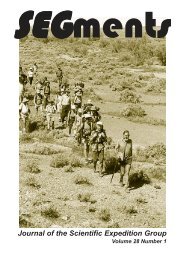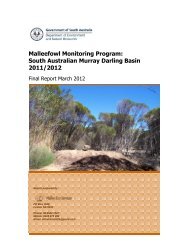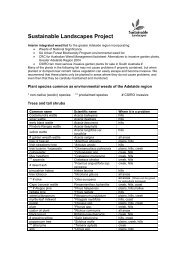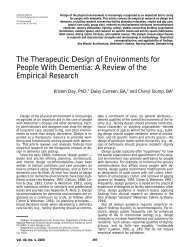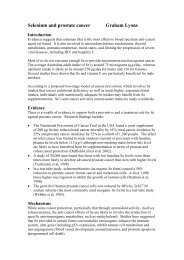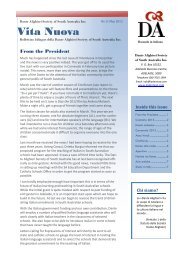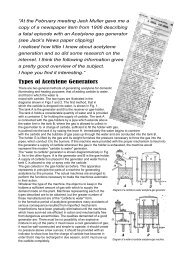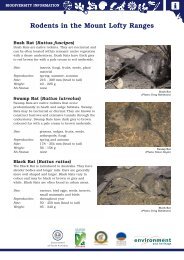Cultivate Fact Sheet 6 SENSORY GARDENS - Communitywebs.org
Cultivate Fact Sheet 6 SENSORY GARDENS - Communitywebs.org
Cultivate Fact Sheet 6 SENSORY GARDENS - Communitywebs.org
Create successful ePaper yourself
Turn your PDF publications into a flip-book with our unique Google optimized e-Paper software.
<strong>Cultivate</strong><br />
<strong>Fact</strong> <strong>Sheet</strong> 6<br />
<strong>SENSORY</strong> <strong>GARDENS</strong><br />
Sensory Gardens<br />
What is a sensory garden The world is a sensory garden.<br />
Our senses allow us to perceive & experience the world.<br />
There are five traditional sensory modes: sight, smell, touch, taste & sound.<br />
But there are other senses, less commonly talked of, just as powerful, if more subtle: the<br />
haptic sense (awareness of our body in pace), gravity, temperature, space & enclosure.<br />
All gardens simulate the senses, to a greater or lesser degree.<br />
You can design your garden to enhance this sensory panoply (the quality & nature of its<br />
spaces, boundaries, climate, materials, plants & fauna). If one of your senses is limited, you<br />
can explore other ways of making the garden full of sensory pleasures & curiosities.<br />
A sensory trail provides a similar but more a structured sensorial journey, compared to a<br />
sensory garden. Along a sensory trail, different senses are sequentially stimulated &<br />
aroused (often encouraging you to explore texture, listen acutely for sounds, experience<br />
smells & a variety of spaces.<br />
The following list, by no means complete, suggests ways of enhancing the sensory<br />
dynamics of your garden.<br />
Visual attributes: Colour, contrast, luminosity, form, shape.<br />
Colour can be used to create the mood and sense of spaciousness of your garden, as well as<br />
for accent. Colour contrast (opposite on the colour wheel), colour harmony (close on the<br />
colour wheel), and colour temperature (cool or warm colours), colour intensity are all<br />
variables that can be explored.<br />
Foliage colour: Colour is not the sole preserve of flowers. Plant foliage & bark are just as<br />
important.<br />
Plants with interesting foliage colour include:<br />
Acacias (dark green to glaucous)<br />
Grasses (Poa, Festuca glauca, Pennesetum, Stipa).<br />
Cordylines (red, variegated)<br />
Bromeliads (many colours)<br />
Deciduous species such as Melia, Acer.<br />
<strong>Cultivate</strong> <strong>Fact</strong> <strong>Sheet</strong> 7: Sensory Gardens<br />
Aileen Westbrook © 25 February 2007<br />
Page 1 of 8
Shape & form<br />
The shape of garden spaces (linear, geometric or curved & flowing) affect ones’ movement<br />
through space & apprehension of it. The shape of garden elements, structures (paths,<br />
boundaries, garden beds) and plants, smooth or abrupt edges, minimal or curlicued, all<br />
these can be played with.<br />
Texture<br />
Plants with interesting textures include:<br />
Rough & smooth barked barked Eucalyptus<br />
Lagerstroemia indica<br />
Gordonia axillaris<br />
Melaleuca<br />
Succulents<br />
Plants with interesting seed heads, pods, fruit<br />
Casuarina<br />
Banksia serrata<br />
Banksia robur<br />
Stachys lanata<br />
Callistemon<br />
Pelargonium<br />
Mosses<br />
Taste<br />
There are many edible ornamental plants. Some obvious examples are vegetable, fruit &<br />
herbs. These plants are highly decorative as well as productive.<br />
Edible plants are rewarding to grow because they do not require too much care<br />
And they are very decorative. Examples are<br />
Beetroot<br />
Lettuces<br />
Rhubarb<br />
Shallots<br />
Silverbeat<br />
Syzygium<br />
Aromatic Plants<br />
Flowers are not the only sources of garden scents. Many plants have aromatic foliage,<br />
culinary herbs being just one example. Examples of plants with fragrant flowers and/or<br />
foliage are given below:<br />
Herbs for scent<br />
Thymus<br />
Majorum<br />
Mentha<br />
Nasturtium<br />
Lavandula<br />
<strong>Cultivate</strong> <strong>Fact</strong> <strong>Sheet</strong> 7: Sensory Gardens<br />
Aileen Westbrook © 25 February 2007<br />
Page 2 of 8
Rosmarinus<br />
Trees and shrubs for scent<br />
Backhousia citriodora (lemon-scented leaves)<br />
Darwinia citiodora (lemon-scented leaves)<br />
Eriostemon myoporoides<br />
Eucalyptus species e.g. E. citriodora<br />
Gardenia sp.<br />
Helioptrope arborescens<br />
Leptospermum petersonii (lemon-scented leaves)<br />
Murraya paniculata (fragrant flowers)<br />
Pelargonium (many with scented foliage)<br />
Plumeria rubra (fragrant flowers)<br />
Prostanthera sp.<br />
Thryptomeme saxicola<br />
Tulbaghia<br />
Viola odorata<br />
Plants with Movement<br />
Grasses<br />
Pennisetum alopecuroides (soft plumes like foxtails)<br />
Poa labilliardieri<br />
Isolepis nodosa<br />
Stipa<br />
Themeda australis (Kangaroo Grass)<br />
Perennials (tall, wispy varieties):<br />
Cosmos (especially chocolate scented Cosmos atrosanguineus)<br />
Salvia patens, S. uliginosa, many others<br />
Interesting Climbers<br />
Akebia quinata (chocolate scented flowers)<br />
Trachelospermum jasminoides (scented)<br />
Hoya carnosa (waxy pretty flowers)<br />
Fauna attracting plants<br />
Butterfly attracting plants include<br />
Austrodanthonia (Wallaby Grass)<br />
Chrysocephalum (Helichrysum)<br />
Lomandra<br />
Pimelea (Rice Flower)<br />
Poa<br />
Stylidium graminifolium (Trigger Plant)<br />
Themeda australis (Kangaroo Grass)<br />
Xanthorrhoea<br />
<strong>Cultivate</strong> <strong>Fact</strong> <strong>Sheet</strong> 7: Sensory Gardens<br />
Aileen Westbrook © 25 February 2007<br />
Page 3 of 8
Birds are attracted to small leafed native plants including<br />
Acacia<br />
Callistemon<br />
Correa<br />
Grevillea<br />
Hakea<br />
Correas<br />
Banskias<br />
Callistemon<br />
Plants to propagate<br />
Succulents are easy to propagate from cuttings, & frequently require minimal care or<br />
watering. There are many varieties with extraordinary textures & forms, and are well worth<br />
experimenting with in the garden.<br />
Suggestions for getting started<br />
• Begin with easy care plants & seek advice from local nurseries.<br />
• Native Plants: Try planting species indigenous to your locale, as they are often well<br />
adapted to the climatic conditions.<br />
• Poisonous & Dangerous Plants: Avoid plants with thorns, and toxic parts,<br />
especially if children visit the garden.<br />
• Weeds: Always consider consulting a garden designer or your local nursery to assist<br />
with plant selection suitable for your climate, location and needs. Some species<br />
grown outside their natural habitat are considered noxious weeds. Consult you local<br />
council for information on weed species in your area.<br />
References<br />
Adil, J.R. Accessible Gardening for People with Physical Disabilities: A Guide to Methods, Tools<br />
and Plants. Bethesda Maryland: Woodbine House, 1994.<br />
Cooper Marcus, C. and Barnes, M. Gardens in Healthcare Facilities: Uses, Therapeutic Benefits<br />
& Design Recommendations. New York: Wiley, 1999.<br />
DeHart M.R. and J.R. Brown. Horticultural Therapy: A Guide for All Seasons. St Louis:<br />
National Garden Clubs, 2001.<br />
Elliot, P. The Garden & the Handicapped Child. London:<br />
The Disabled Living Foundation, 1978.<br />
<strong>Cultivate</strong> <strong>Fact</strong> <strong>Sheet</strong> 7: Sensory Gardens<br />
Aileen Westbrook © 25 February 2007<br />
Page 4 of 8
Francis, M, and Hester, R.T. (eds). The Meaning of Gardens. Cambridge, Massachusetts: MIT<br />
Press, 1990.<br />
Handreck, K. Gardening Down-Under. East Melbourne: CSIRO Publications, 1993.<br />
Hewson, M.L. Horticulture as Therapy: A Practical Guide to Using Horticulture as a Therapeutic<br />
Tool. Canada: Greenmor Printing, 1994.<br />
Pease, P. (ed). Able to Garden: A Practical Guide for the Disabled & Elderly Gardeners. London:<br />
Batsford, 1990.<br />
Rothert, G. The Enabling Garden: Creating Barrier-Free Gardens. G. Dallas: Taylor Publishing<br />
Co, 1994.<br />
Simpson, S.P. and Straus, M. (eds). Horticulture as Therapy: Principles & Practice. New York:<br />
Haworth Press, 1998.<br />
Tyson, M. The Healing Landscape: Therapeutic Outdoor Environments. New York: McGraw-<br />
Hill, 1998.<br />
Ulrich R. ‘Effects of Gardens on Health Outcomes: Theory & Research’ In Cooper Marcus,<br />
C. & Barnes, M. Healing Gardens: Therapeutic Benefits & Design Recommendations. New York:<br />
John Wiley & Sons, 1999.<br />
Well, S.E. (ed). Horticultural Therapy and the Older Adult Population. New York: Haworth<br />
Press, 1997.<br />
References on garden design & plants<br />
Alexander, R. The Essential Garden Design Workbook. Portland, Oregon: Timber Press, 2004.<br />
Cave, Y. Succulents for the Contemporary Garden. Florilegium: Glebe, 2002.<br />
Dean, E. Esther Dean’s Gardening Book: Growing without Digging. Sydney: Harper & Row,<br />
1977.<br />
Edmanson, J. and Lawrence, L. The Australian Garden. Viking, Ringwood, 2000.<br />
French, J. Yates Guide to Herbs. Sydney: Angus & Robertson, 1994.<br />
Grieg, D. Flowering Natives for Home Gardens. Sydney: Angus & Robertson, 2001.<br />
Guest, S. Flowering Perennials. South Melbourne: Hyland House, 1996.<br />
<strong>Cultivate</strong> <strong>Fact</strong> <strong>Sheet</strong> 7: Sensory Gardens<br />
Aileen Westbrook © 25 February 2007<br />
Page 5 of 8
McHoy, P. The Complete Garden Planning Book. London: Hermes House, 1999.<br />
Snape, D. The Australian Garden. Melbourne: Bloomings Books, 2002.<br />
Taylor, J. Planning Your Garden for Retirement. Lothian: Port Melbourne, 1990.<br />
Wrigley, J. and Fagg, M. Starting Out with Natives: Easy–to-Grow Plants for Your Area.<br />
Sydney: Reed New Holland, 2002.<br />
Resources & Links<br />
Organisations & Associations<br />
• <strong>Cultivate</strong><br />
Horticultural Therapy Society of NSW<br />
Telopea Centre<br />
250 Blaxland Road<br />
Ryde NSW 2112<br />
(02) 9448 6392<br />
• Victorian Horticultural Therapy Association<br />
http://www.greenweb.com.au<br />
• Thrive<br />
The Geoffrey Udall Centre<br />
Beech Hill<br />
Reading England<br />
RG7 2AT<br />
http://www.thrive.<strong>org</strong>.uk<br />
• Chicago Botanic Garden<br />
Horticultural Therapy Services<br />
1000 Lake Cook Road Glencoe<br />
Illinois 60022<br />
http://www.chicagobotanic.<strong>org</strong>/therapy<br />
• The American Horticultural Therapy Association<br />
909 York Street<br />
Denver Colorado 80206-3799<br />
http://www.ahta.<strong>org</strong><br />
• The Australian Association of Occupational Therapists<br />
http://www.otnsw.com.au/index.php<br />
<strong>Cultivate</strong> <strong>Fact</strong> <strong>Sheet</strong> 7: Sensory Gardens<br />
Aileen Westbrook © 25 February 2007<br />
Page 6 of 8
• Independent Living Centre of NSW<br />
http://www.ilcnsw.asn.au<br />
• The Northcott Society<br />
Northcott provides services, support, products, and information for people with<br />
disabilities.<br />
http://www.northcott.com.au<br />
Journals<br />
• GrowthPoint: Journal of Social and Therapeutic Horticulture<br />
The Geoffrey Udall Centre<br />
Beech Hill<br />
Reading England<br />
RG7 2AT<br />
http://www. thrive.<strong>org</strong>.uk<br />
• Journal of Therapeutic Horticulture.<br />
American Horticultural Therapy Association.<br />
Denver Botanic Gardens<br />
909 York Street, Denver CO 80206-3799<br />
http://www.ahta.<strong>org</strong><br />
Related Links<br />
Use Internet search engines with the key words: sensory garden, enabling garden, healing<br />
garden, accessible garden, horticultural therapy, and barrier-free gardening. Some<br />
interesting & helpful sites are listed below.<br />
• Australian Society for Growing Native Plants.<br />
http://asgap.<strong>org</strong>.au<br />
• Garden Forever<br />
(Many wonderful links for gardeners with disabilities, arthritis, allergies).<br />
http://www.gardenforever.com<br />
• Gardening for Good<br />
Great sites with suggestions for gardeners.<br />
http://www.gardening4good.<strong>org</strong><br />
http://www.gardenscape.on.ca/pages/linksenable.htm<br />
http://www.carryongardening.<strong>org</strong>.uk<br />
<strong>Cultivate</strong> <strong>Fact</strong> <strong>Sheet</strong> 7: Sensory Gardens<br />
Aileen Westbrook © 25 February 2007<br />
Page 7 of 8
• Guelph Enabling Garden<br />
www.enablinggarden.<strong>org</strong><br />
• Noah’s Ark Gardens for ideas on sensory gardens<br />
http://www.noahsarkgardens.co.uk/Articles/SensoryGarden.htm<br />
• Wangee Park School, NSW has a wonderful sensory garden<br />
http://www.wangeepark-s.schools.nsw.edu.au/links.htm<br />
<strong>Cultivate</strong> <strong>Fact</strong> <strong>Sheet</strong> 7: Sensory Gardens<br />
Aileen Westbrook © 25 February 2007<br />
Page 8 of 8




